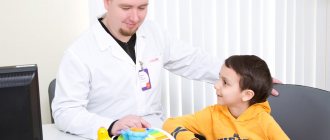Today, the aggressive behavior of children of preschool and school age, which now appears quite often, is of particular relevance. Psychologists attribute open manifestations of aggressiveness in children to obvious violations of the child’s habitual behavior. Aggressive behavior in preschool children manifests itself in the form of disobedience, excessive activity, pugnacity, or cruelty towards others. Aggression can manifest itself in verbal form or in mixed form, when children try to fight with children, which can be especially often observed in kindergarten. This form of behavior is unacceptable for society and requires some correction. But first you need to find out the reasons for the appearance of this type of aggression.
Aggression in children can appear at any age
Causes of aggressive behavior in children
Aggressive children do not become aggressive on their own; there are the following objective reasons for this:
- the desire to attract the attention of surrounding peers by any means;
- the intention to get the desired thing;
- the desire to always be in charge in everything;
- certain protection and speedy revenge on the offender;
- the desire to humiliate the dignity of another child in order to increase one’s own superiority.
Aggressive behavior in children is a desire to get their way.
Based on these reasons, it is necessary to actively stimulate strong-willed behavior in the child, the manifestation of independence in order to teach him to express his feelings more calmly.
Which families are more likely to produce deviant children?
There is no clear dependence of deviations on the child’s family, that is, deviant children are found in both complete and incomplete families, prosperous and dysfunctional. However, experts have identified several typical families that contribute to the formation of deviant behavior in a child:
- Families where parents suffer from mental disorders or addictions.
- Asocial families.
- Families where one of its members is seriously ill.
- Families in which there is a phenomenon of child suppression, violence (psychological, physical), deprivation (deprivation of parental attention, love, failure to fulfill parental household responsibilities).
- Families where one or both parents did not want the child, which results in dislike for him.
- Families with increased severity, control, despotic or authoritarian parenting style.
- Families with excessive indulgence of the child, excessive guardianship.
- Families where parents do not respect each other; there are quarrels, scandals, violence.
Raising a child's strong-willed behavior
Educational work with aggressive children should not be aimed at suppressing these feelings in the child by giving out what they want, that is, parents make a mistake by suppressing the manifestation of aggression in the child, considering this to be similar to violence. This is not a pathology, but everyone has reasonable outbursts of anger, but children who are prohibited from such games and fantasies have the opinion that these feelings are vile and do not need to be shown. But unexpressed feelings of aggression simply begin to accumulate unconsciously in the child. One fine day it simply explodes, and people who are not at all to blame suffer.
Aggression towards other children manifests itself in pugnacity
Children's aggression encounters a backlash from adults, and as a result, a forbidden circle is formed, from which it is almost impossible for a little person to get out of it on his own.
The strong-willed behavior of children in kindergarten should be a priority task for every teacher.
Age-related characteristics of will in children of different ages
The development of a child’s will is formed during active play activities.
Such behavior means that before taking any action, the child outlines an approximate course of action and acts in a similar way to a well-thought-out move. It is at the age of 3-4 years that the child begins to realize that it is not always possible to do what he wants at this moment. He begins to develop self-control. The development of volitional behavior in preschoolers is expressed in the desire to demonstrate their independence by doing simple actions. The kid demands: “I myself,” despite protests from adults. During this period, children tend to show a certain amount of restraint and patience if this can bring him a certain amount of pleasure. The ability to restrain one's negative behavior increases several times in children of preschool age.
Types of aggression in children
Control over one's own actions, obedience and commitment awaken in children at the age of 4 years. During this period, you need to actively develop your children’s ability to be independent, encouraging every right step along the way.
In addition to the manifestation of aggression and the development of the volitional qualities of a preschooler, some children at this age may develop some anxiety or restlessness. What is the reason for this anxiety?
What is anxiety - definition
The main causes of childhood anxiety
Typically, anxiety in children begins to actively manifest itself at primary school age.
Causes of anxiety in children are mainly due to family reasons
The behavior of anxious children is directly due to the following reasons:
- The family factor is the main reason why children develop anxiety. Such children are insecure in contrast to their emotionally well-off peers.
- First school successes can also trigger anxiety. Such children show their dissatisfaction with their personal performance, even if they do not have bad grades, there will always be reasons for dissatisfaction. In addition, children are always afraid of disappointing their parents with a bad grade or reprimand from the teacher.
- Active relationships with teachers. Conflicts, severe rudeness and tactless behavior of teachers towards children can also cause anxiety in children. Unprofessional teacher behavior can increase anxiety levels in the classroom. This behavior has a particularly detrimental effect on children who already felt anxious before entering school.
- Relationships with peers. Such children occupy various positions in the society of the class - from the position of an outcast student to the star of the class. Anxiety in this case acts as a factor in the emotional dependence of schoolchildren on their peers. Anxious children feel defenseless and dependent when in such a society.
- The emerging internal conflict associated with personal self-esteem can also cause various anxious feelings.
- Negative emotional experience in a primary school student is formed as a result of imprinting in memory exclusively negative, unsuccessful events. The active accumulation of negative experience is expressed in a persistent feeling of anxiety.
Types of anxious children - characteristics
It is for these reasons that a primary school teacher should carry out various activities aimed at reducing the level of anxiety among primary schoolchildren so that this condition does not take root in adolescence.
Pedagogical methods for reducing anxiety levels in children
During primary school age, the child’s psyche is actively developing. To prevent low school performance and other psychological reasons from becoming a reason for fear of school in children, the teacher must actively use special correctional classes during the learning process in order to provide psychological support to younger schoolchildren. This is a specific system of classes, practical exercises aimed at teaching important techniques for mastering the unpleasant feeling of excitement and anxiety. It should also provide children with important practical techniques for recognizing and responding to their own expressions of negative emotions and aggression. The program also actively introduces game methods that are important for this age, and methods of active group discussion.
Ways to reduce anxiety in group classes
A working correction plan should include the point of active interaction with the parents of an anxious child.
Childhood fear in a child is directly related to active learning activities, during which there is a fear of making a mistake, receiving a negative assessment of one’s knowledge, and fear of conflict with peers. In this case, the teacher will find 2 available ways to overcome feelings of anxiety in schoolchildren useful:
- formation of constructive behavior in difficult situations for the student, as well as mastering effective ways to overcome excessive excitement and anxiety;
- strengthening the child’s self-confidence and abilities, developing adequate self-esteem, developing a normal idea of one’s own personality, caring for the personal growth of each student.
Communication with children dispels fears.
Such activities should not be excluded in adolescence, because here all methods acquire special importance, given the difficult situation of this critical period.
Prevention of deviant behavior
To prevent the development of deviations in children and adolescents, parents need to pay attention to both the family attitudes and upbringing models adopted in their family, and the psychological atmosphere surrounding their child at school or kindergarten. It is important to create an atmosphere of acceptance, understanding and security in the family. At the same time, it is necessary to ensure clarity of boundaries and rules in the family: what is prohibited in our family, and what is permissible in our family is allowed. It is important that parents have a clear understanding of the principles on which they are raising their children, what goals they are trying to achieve, and whether their methods of achieving educational goals are effective and whether they do not cause more harm to children. It is equally important that family rules are communicated and explained to children, because only understanding will ensure that children ultimately adopt these rules as their own. Otherwise, incomprehensible rules and double standards imposed by force cause a desire to break them in every case when punishment can be avoided. It is also necessary to take into account and clarify the motives of the little person’s behavior in order to avoid unfair punishment in cases where he was driven by an understandable desire to protect himself, perhaps in a not entirely constructive way. In this case, the main goal of the parents is to understand what happened and help him choose socially acceptable ways to regulate relationships. It is also very important to provide a girl or boy with a person-centered approach in educational institutions, at least by choosing a school with appropriate values and principles of education. Flexibility in relation to educational opportunities will help to avoid situations of chronic failure and will allow the student to adequately assess his contribution and responsibility in educational activities. Parents can provide great assistance to children in the development of emotional and social intelligence by explaining the emotional states of them and other people in interaction situations: what a person feels, why he reacts in this way, how the situation could be resolved in a better way, etc. Children and adolescents need to name their states and expand their experience in building relationships with other people. A teenager with developed social and emotional intelligence is less susceptible to irritability and impulsive behavior, is emotionally more stable and his adaptive capabilities are higher - which means that in a new and difficult situation for him, he is less at risk of reacting in a disturbed way.
Types of antisocial behavior in adolescents
At this time, many teenagers behave deviantly, that is, they deviate from general moral norms; these deviations can be aggressive, selfish or socially passive.
Forms of antisocial behavior in adolescents
School psychologists identify the following types of deviant behavior:
Conformal behavior , that is, a tendency to develop passive forms of response to long-term overcoming tension during a difficult situation. In the event of a conflict, such a teenager shows compliance, takes on extra responsibilities, without feeling the strength to refuse.
Inhibited behavior is a type of manifestation of maladjustment. Rapid changes in the social environment can cause feelings of anxiety, low self-esteem, lack of confidence in one’s own strength, and suspicion in a teenager about his or her health.
Limited, that is, driven behavior , when a teenager shows excessive compliance in relation to stronger peers. In difficult situations, adolescents actively demonstrate their own helplessness, a certain amount of stubbornness, increased sensitivity, adhering to external conflict-free behavior.
Causes of behavior disorders in adolescents
Self-centered type of behavior , when teenagers try to actively involve others in their own experiences, artificially exaggerating many aspects of a conflict situation.
A conflict-excitable variant of deviant behavior in adolescents , they are characterized by stubbornness, the desire to impose their will on weak peers, and a disdainful attitude towards the interests of others. Such teenagers easily turn into a negative leader who is able to lead his aggressive group. They begin to actively use physical coercion on children who are weaker both physically and morally.
Conflict form of behavior - violation of prohibitions
At this age, some teenagers begin to behave antisocially, actively violating generally accepted norms.
Such actions can often be criminally punishable for a teenager. There are also delinquent offenses by children aimed at destroying moral standards, but not entailing criminal liability due to their underage age.
Aggression in teenagers often takes ugly forms
This type of behavior includes the following:
- periodic running away from home, vagrancy;
- severe aggression, including manifestations of vandalism;
- various suicidal actions;
- early use of alcohol or drugs;
- early sexual intercourse and sexual deviation;
- petty thefts, various types of theft and extortion.
Behavioral disorders in adolescents
These are the main types of behavior of adolescents aimed at destroying generally accepted principles. How can we help such children get out of this vicious circle?
Conditions for the occurrence of aggression
What is deviant behavior?
Let's start with a short historical excursion. The term “deviant behavior” comes from the word deviation, which in most European languages means “deviation”. The first concept of “deviance” or “deviance” was introduced into scientific circulation by the French philosopher and sociologist David Emile Durkheim (1858-1917).
The focus of his scientific attention was the topic of social integration in a rapidly changing society, which was fully observed in Europe in the second half of the 19th century. His work “Suicide: a sociological study”, first published in 1897, translated into many languages of the world and went through many reprints, became a landmark work [E. Durkheim, 1994].
This book examines various aspects of suicidal behavior as deviating from generally accepted norms and basic instincts. In addition, Emile Durkheim used the definition of “anomie” in relation to a society in a state of disorganization and disorientation, when the very concept of norm becomes blurred. It is quite logical that in this case it is much more difficult to determine what is a deviation from the norm than in conditions of stability.
One way or another, today deviant refers to human behavior that deviates from generally accepted and most widespread social norms in a given society at a given point in time. This refers to both expected social behavior adapted to the requirements of society and deviant behavior that deviates from the standard and social expectations.
We have already clarified that different communities may have different concepts of the norm at the beginning of the article. Relatively speaking, the standards of behavior among members of the academic council of the university and the society of anonymous alcoholics will differ markedly.
I think everyone can see for themselves how social norms change over time. Suffice it to say that in the United States, which considers itself a model of democracy, there was an official ban on interracial marriages until 1967, and violation of the ban was punishable by imprisonment. Interestingly, in the state of Alabama this ban was lifted only in 2000. You can read about the ups and downs of the struggle of Americans for the right to love each other regardless of skin color [B. Cabell, 1999].
We gave this example solely to illustrate how the concept of a social norm can change in just about 50 years. What was once a criminal offense is now a taken-for-granted right of all and everyone, which does not even occur to anyone to discuss or question. And if it comes, then doubts of this kind can be interpreted as a violation of the law and discrimination on the basis of race.
Another thing remains unchanged: violation of established norms leads to sanctions from society, ranging from moral condemnation to imprisonment. In other words, it does not matter what is meant by the norm. The important thing is that a violation can result in imprisonment. Until 1967, people in the United States were jailed for interracial marriage, but now they are jailed for refusing to register same-sex marriages [BBC, 2015]. What they would do in the United States with a judge who would decide to refuse to register an interracial marriage, we cannot even imagine.
The traditionally negative connotation of the very concept of “deviant human behavior” remains unchanged, although “deviant” only means “deviant.” And deviations, as we have already found out, can be in any direction. For example, parents who abuse alcohol may grow up to have a purposeful son who leads a healthy lifestyle and wants to get an education and a profession. But in this case, he will face misunderstanding and even condemnation from his relatives, who are perplexed about what kind of nonsense this higher education is.
Nevertheless, it is necessary to distinguish between positive and negative deviation:
- Negative deviation includes any crimes and offenses, alcoholism, drug addiction, prostitution, harassment, unethical behavior, manifestations of mental disorders in the form of suicidal tendencies, self-harm and others.
- Positive deviation includes self-sacrifice, heroism, altruism, workaholism, a heightened sense of pity, outstanding talents and abilities, giftedness, etc.
Forms of behavior classified as positive deviation are certainly a deviation from the norm, because not all people have any obvious talents, and few are able to risk their lives to save another person.
The distinction between positive and negative deviation has more of a cognitive rather than an applied aspect. The subject of scientific and practical research in the vast majority of cases is precisely negative deviation as representing the greatest potential danger. Based on all of the above, we can identify the main signs of deviant behavior in the context of negative deviation.
Signs of negative deviant behavior:
- Does not correspond to the norms accepted or officially established at a given time in a particular society.
- It has a stable, repeatable character.
- Causes a negative response from others or so-called “social sanctions”.
- May be subject to forced correction by the state (imprisonment, compulsory treatment, other forms of isolation).
- Causes damage to the person committing deviant behavior and/or the people around him.
- Accompanied by social maladjustment.
- May have medical, social or psychological causes.
And finally, it is worth outlining the age boundaries of the phenomenon. At what age can behavior that does not correspond to social norms be considered deviant? It is clear that the baby cannot behave in accordance with the norms accepted in society. And in principle, he cannot be aware of himself, his behavior and everything that is happening around him.
When considering the deviant behavior of children, experts usually agree that this term should be applied to children starting from older preschool age, because earlier, for objective reasons, they cannot fully understand the consequences of their even the simplest everyday actions. Up to 5 years of age, deviations in children’s behavior can be considered the norm [Yu. Zhokhova, 2017].
Therefore, when talking about deviations, we will mean children aged 5 years and older, teenagers and adults. As you already understand, deviant behavior in society can have a variety of reasons and a variety of manifestations. Let's talk about this in more detail.
Important psychological help: advice for parents
How can we pull teenagers out of this abyss of immoral behavior? These negative behaviors of adolescents need to be brought under control by adults; this is a task for social services.
An atmosphere of friendliness in the family is a guarantee that your son or daughter will never exhibit negative types of behavior.
Family problems are a common cause of aggression
To prevent children from having similar problems in the future, it is necessary to take care of this from an early age. It is necessary to pay attention to your child: give him love and tenderness in full, never use abusive words in their presence. You need to talk with your baby on various topics, share your emotions and experiences. You need to listen to the child’s opinion, become a devoted comrade for him, then only there is an opportunity to avoid antisocial forms of behavior.
Motivation for teenagers is an important factor in eliminating aggressiveness
Various social services, hotlines, and regional family consultations with psychologists provide enormous assistance in the rehabilitation of deviant adolescents. To protect susceptible teenagers from the negative influence of the surrounding criminal world, schools need to conduct themed classes. The task of every parent is to explain to their growing teenager what true good and harmful evil are, that committing violations of the law is very bad, causing tangible harm to someone or causing pain to the weak is simply unacceptable, and such behavior will certainly be punished.
Basic ways to correct anxiety
It is necessary to raise a child to be a cheerful optimist, to be a shining example for him, constantly reminding him that life is simply wonderful, and almost everyone has dark moments, but they bring some variety to everyday life.
It is necessary to convey to the child that even insurmountable difficulties are not a reason for suicide, because he is still so young and has a life ahead of him filled with interesting and joyful events. leave a comment
Causes of deviations
Domestic psychologist and sociologist Igor Semenovich Kon identified among the leading causes of deviations in children and adolescents:
- teenager's problems at school;
- mental trauma;
- negative influence of the group on an unformed personality;
- decreased self-esteem and low personal self-esteem.
Thus, the following factors and reasons can provoke deviant behavior in children and adolescents:
- instability of the psyche, weakness of processes;
- high or low self-esteem, lack of self-confidence, excessive demands on oneself (including from parents and teachers);
- problems in communication, problems with socialization among peers;
- craving for imitation, dependence on external opinion;
- primary deviations (many forms of deviant behavior arise against the background of existing ones);
- pathological lesions of the brain in ontogenesis (injuries, diseases, congenital anomalies);
- inclusion in youth subcultures;
- family dysfunction, parental addictions, burdened heredity;
- superimposition of the reaction of emancipation on the reaction of grouping with peers;
- low level of culture of parents and low standard of living of the family.
In recent decades, the level of physical, moral and spiritual health of children has begun to decline sharply. As a result, problems often appear in the development of children, which are expressed in deviations (deviations) from generally accepted social age expectations.







